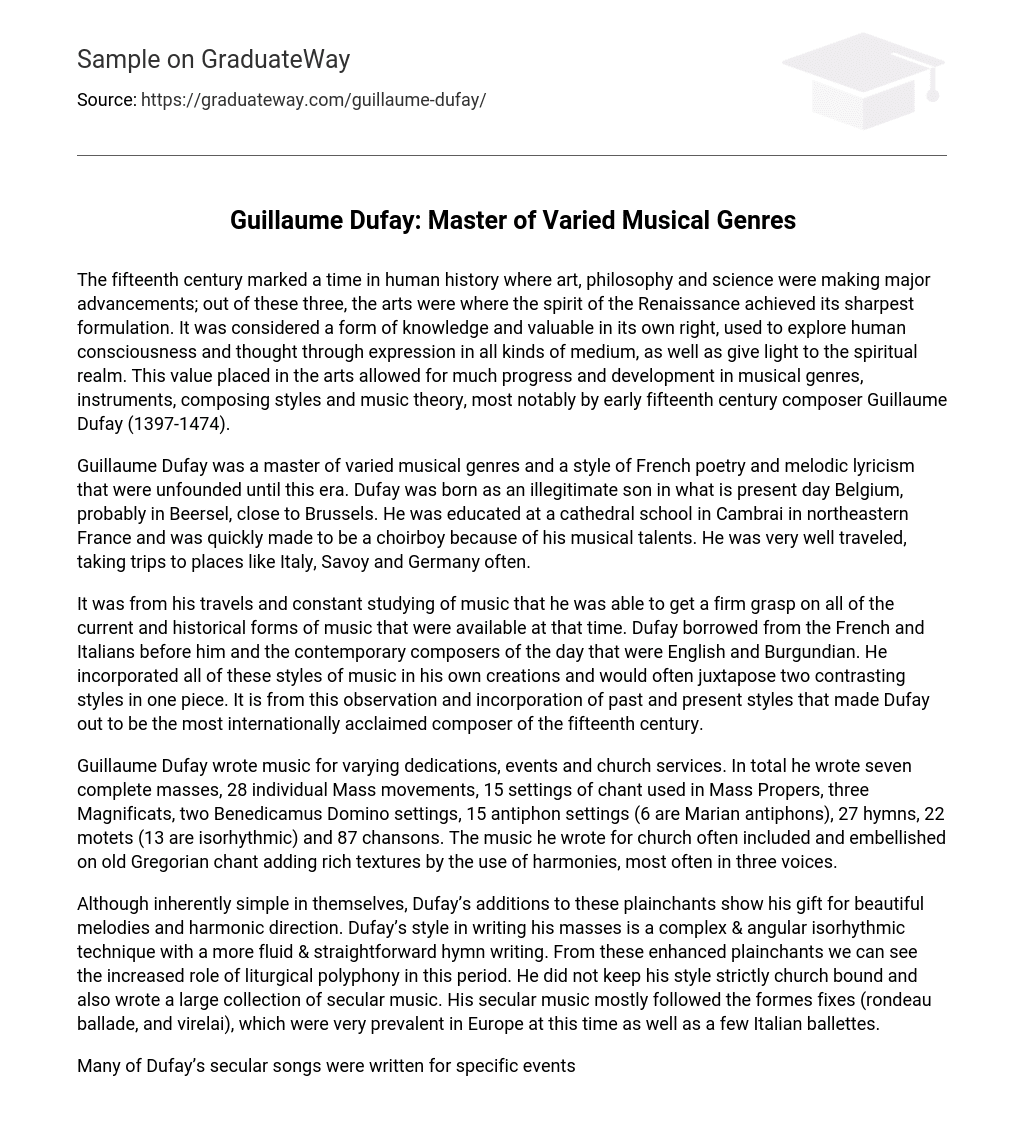During the fifteenth century, significant advancements were being made in art, philosophy, and science. Among these disciplines, the arts served as the primary outlet for expressing the spirit of the Renaissance. Regarded as a form of knowledge in its own right, the arts were utilized to explore human consciousness and thoughts through various mediums, while also shedding light on the spiritual realm. This emphasis on the value of the arts led to significant progress and growth in musical genres, instruments, composing styles, and music theory. One notable figure in this development was Guillaume Dufay (1397-1474), a composer active in the early fifteenth century.
Guillaume Dufay, a composer adept in various musical genres and a pioneer of French poetry and melodic lyricism, emerged during a time when such innovation was unprecedented. Dufay, born out of wedlock, most likely in Beersel near Brussels, Belgium, received his education at a cathedral school in Cambrai, a region in northeastern France. His remarkable musical abilities quickly earned him a role as a choirboy. Known for his extensive travels, Dufay frequently journeyed to destinations such as Italy, Savoy, and Germany.
Through his travels and extensive study of music, Dufay gained a deep understanding of the various forms of music that were present during his time. He drew inspiration from both French and Italian predecessors as well as contemporary English and Burgundian composers. Dufay skillfully blended these different styles in his own musical works, often juxtaposing contrasting elements within a single piece. This ability to incorporate past and present styles contributed to Dufay’s reputation as the most widely celebrated composer of the fifteenth century.
Guillaume Dufay composed music for various dedications, events, and church services. In total, he composed seven complete masses, 28 individual movements for the Mass, 15 settings of chant used in Mass Propers, three Magnificats, two Benedicamus Domino settings, 15 antiphon settings (including six Marian antiphons), 27 hymns, 22 motets (of which 13 are isorhythmic), and 87 chansons. In his church music, he often incorporated and enhanced old Gregorian chants by using harmonies, typically in three voices, to create rich textures.
Dufay’s additions to plainchants demonstrate his skill in creating beautiful melodies and effective harmony. His masses are characterized by a complex and angular isorhythmic technique, while his hymns display a more fluid and straightforward style. Through these enhanced plainchants, the expanded role of liturgical polyphony during this period becomes evident. Dufay also ventured beyond strictly religious compositions, composing a significant collection of secular music. His secular pieces often adhered to the popular European forms of rondeau, ballade, and virelai, as well as some Italian ballettes.
Dufay had a tendency to write secular songs for specific occasions, providing valuable information about their origins. The majority of his secular compositions consist of three parts; however, there are some exceptions. Typically, the highest voice would be sung while the lower two voices were likely played by instruments. Later in his career, Dufay began composing for four voices, showcasing his expertise in fifteenth century polyphony and contributing to the advancement of contemporary music.
Guillaume Dufay composed the Missa Se la face ay pale: Gloria as a sacred piece to be performed during the catholic mass. This work showcases Dufay’s skill in blending different international styles of music and exploring various harmonic ideas. In creating the music, Dufay deviated from the traditional fourteenth century ballade (aab) structure and instead tailored it to fit the text. The French influence is evident in the use of syncopations and a melodic contra tenor line that incorporates large leaps. On the other hand, the English influence can be observed through the frequent use of thirds and sixths, as well as the relatively equal prominence of the cantus and tenor melodies4.
The piece was written during a time of musical transition between the harmonic and melodic cadences of the past and modern cadential material. The tonal center of this mass appears to be F, with C also being an important focus, especially in the tenor line. By including a borrowed tenor line in the mass, Dufay was able to establish F as the root of the chord in the tenor bassus. The occasional use of B-flat also helps to emphasize F as the tonal center. The melody introduced in measure 19 is repeated later in the song, specifically in bars 49 and 83.
Each note value in the Ballade is tripled in length, making it difficult to recognize at first. However, as the melody reappears, it becomes more recognizable. Additionally, in this example of Missa se la face ay pale, the superius line demonstrates a constantly changing rhythm throughout the entire piece, a characteristic typical of Du Fay and noted by contemporary music enthusiasts. Each voice in the piece has its own melodic and rhythmic qualities.
The tenor line acts as the framework for the piece and guides the rest of the voices. The bassus often harmonizes with the tenor line to establish a foundation. The top lines generally move smoothly, occasionally leaping or echoing each other (1-4). Dissonance in this piece is rare, mostly appearing as suspensions or passing quickly. All dissonance is resolved properly throughout the work. Considering Missa Se la face ay pale: Gloria, it becomes evident why Guillaume Dufay was the leading composer of his time. He had a versatile style and his innovations revolutionized music.
Bibliography
The sources used in this text are:
- Hamm, “Guillaume Dufay” Columbia Electronic Encyclopedia, 6th Edition, 11/1/2011 accessed Tuesday October 23rd 2012
- Planchart, Alejandro: “Guillaume Du Fay”, Grove Music Online ed. L. M accessed Tuesday October 23rd 2012
- Roberge, Pierre-F. http://www.medieval.org/emfaq/composers/dufay.html Accessed Monday October 22nd 2012
- “Guillaume Dufay” http://www.naxos.com/person/Guillaume_Dufay/26014.htm accessed Sunday October 21st





